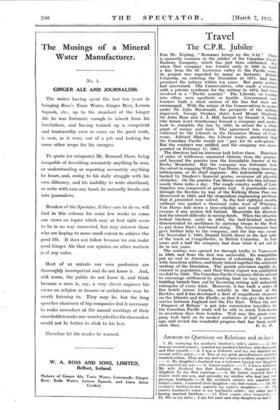Travel
The C.P.R. Jubilee FOR Mr. Kipling, " Romance -brings up the 9.145." There is assuredly romance in the jubilee of the Canadian Pacific Railway Company, which has ,just been celebrated. For when that company was formed early in 1881 to build a line from the St. Lawrence valley to the Pacific coast, its project was regarded by iffany as fantastic. British Columbia, on entering the Dominion- in 1871; had been promised the railway within ten years. But party polities had intervened. The Conservatives, who made a contract with a private syndicate for the-railway in 1872, had been involved in a " Pacific scandal." The Liberals, on coming into office, were apathetic or hostile. Govermnent con- tractors built _a _short section of the line -but _ were not encouraged. With the return of .the Conservatives to power under Sir John Macdonald, the prospects of the railway improved. George Stephen (later Lord Mount Stephen), Sir John Rose and J. J. Hill, backed by Donald A. Smith (the future Lord Strathcona) formed a company and under- took to complete the line by 1891, in return for a State grant of money and land. The agreement was violently criticized by the Liberals in the Dominion House of Com- mons. Edward Blake, the Liberal leader, predicted that the Canadian Pacific would not " pay for its axle-grease." But the contract was ratified, and the company was incor- porated on February 17, 1881. The directors had an immense task before them. Hundreds of miles of wilderness separated Ontario from the prairies, and beyond the prairies rose the formidable barrier of the Rocky Mountains. But the company was fortunate from the outset in engaging William Van Horne, the young American railwayman, as its chief engineer. His indomitable energy, backed by Stephen's financial genius, overcame all physical obstacles. On the prairies Van Horne made the line advance nearly three miles a day. The rough country north of Lake Superior was conquered at greater cost. A practicable route through the Rockies by way of the Kicking Horse Pass was discovered in 1883, and the stupendous engineering problems that it presented were solved. In the first eighteen months railhead was pushed a thousand miles west ot Winnipeg. Van Horne laid down a time-schedule and would suffer no excuses if any section fell behind. Meanwhile his directors had the utmost difficulty in raising funds. When the situation looked blackest, early in 1885, the half-finished railway demonstrated its usefulness by carrying troops to the West to put down Riel's half-breed rising. The Government then gave further help to the company, and the line was saved. On November 7, 1885, Donald Smith drove in the last spike of the track at Craigellachie, in British Columbia. In four years and a half the company had done what it set out to do in ten years.
The railway was opened for through traffic to Vancouver in 1886, and from the first was successful. Its completion put an end to American dreams of colonizing the prairies with American settlers, and firmly linked together the scattered sections- of the Dominion. The prairie provinces rapidly in- creased in population, and their wheat export was multiplied six-fold by 1900. The Canadian Pacific Company did its utmost to encourage settlement by granting land on easy terms, by building branch lines and by favouring mining and industrial enterprise of every kind. Moreover, it has built a series of fine hotels across Canada, notably in the heart of the Rockies, and it has developed a fleet of magnificent steamers on the Atlantic and the Pacific, so that it can give the fastest service between England and the Far East. When the new ' Empress of Britain' is put into commission travellers by the Canadian Pacific route will be able to reach Yokohama in seventeen days from London. Well may this great com- pany look back on its modest ambitions of half a century ago, and review the wonderful progress that has been made


























































 Previous page
Previous page